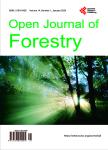Traffic Pollution Influences Leaf Biochemistries of <i>Broussonetia papyrifera</i>
Traffic Pollution Influences Leaf Biochemistries of <i>Broussonetia papyrifera</i>作者机构:Key Laboratory of Vegetation Restoration and Management of Degraded Ecosystems South China Botanical Garden Chinese Academy of Sciences Guangzhou China
出 版 物:《Open Journal of Forestry》 (林学期刊(英文))
年 卷 期:2012年第2卷第2期
页 面:71-76页
学科分类:1002[医学-临床医学] 100214[医学-肿瘤学] 10[医学]
主 题:Amino Acids Broussonetia papyrifera Carbohydrates Phytohormounes Traffic Pollutants
摘 要:Paper mulberry (Broussonetia papyrifera) is one of multifunctional species in agroforestry systems as well as one of traditional forages in many countries of Asia. Fully expanded tender leaves of B. papyrifera wildly growing under two traffic densities (a high traffic loads bearing more than 1000 vehicles per hour, HT;and a relatively clear section with almost no traffic loads, NT) were collected for carbohydrates, amino acids and phytohormones analysis. Leaves exposed to traffic pollutants were revealed to have significant lower amounts of carbohydrates and total amino acids than those growing at relatively clear environment. The levels of abscisic acid in the leaves significantly increased, while gib-berellin acid, indoleaetic acid, and zeatin riboside in the leaves significantly decreased, with the traffic densities. The results indicated that the contents of carbohydrates, amino acids and phytohormones in the leaves of B. papyrifera could be adversely affected by traffic pollution. Variations of the leaf biochemistries of B. papyrifera exposed to traffic pollutants implied that B. papyrifera could physiologically regulate itself to adapt or resist traffic stress.



